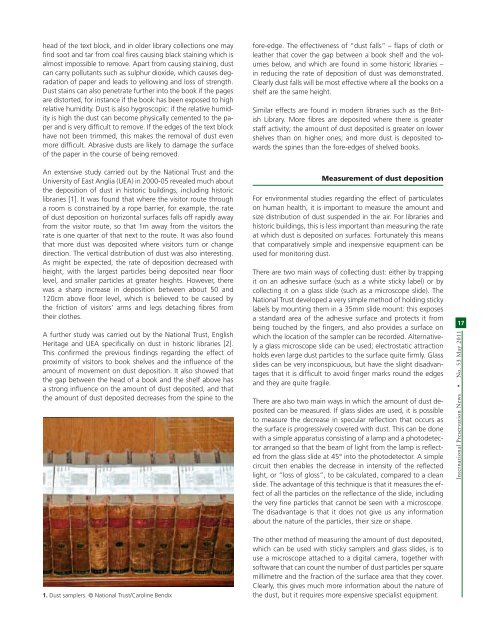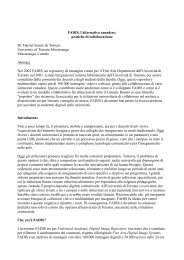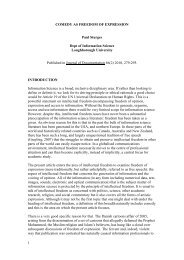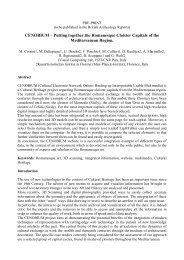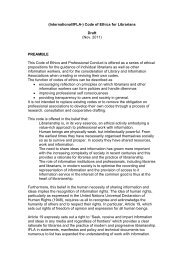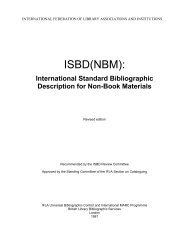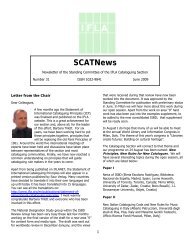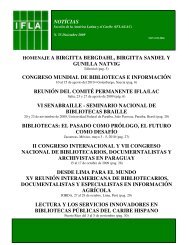Low Cost Dust Monitoring at The British Library - IFLA
Low Cost Dust Monitoring at The British Library - IFLA
Low Cost Dust Monitoring at The British Library - IFLA
You also want an ePaper? Increase the reach of your titles
YUMPU automatically turns print PDFs into web optimized ePapers that Google loves.
head of the text block, and in older library collections one may<br />
fi nd soot and tar from coal fi res causing black staining which is<br />
almost impossible to remove. Apart from causing staining, dust<br />
can carry pollutants such as sulphur dioxide, which causes degrad<strong>at</strong>ion<br />
of paper and leads to yellowing and loss of strength.<br />
<strong>Dust</strong> stains can also penetr<strong>at</strong>e further into the book if the pages<br />
are distorted, for instance if the book has been exposed to high<br />
rel<strong>at</strong>ive humidity. <strong>Dust</strong> is also hygroscopic: if the rel<strong>at</strong>ive humidity<br />
is high the dust can become physically cemented to the paper<br />
and is very diffi cult to remove. If the edges of the text block<br />
have not been trimmed, this makes the removal of dust even<br />
more diffi cult. Abrasive dusts are likely to damage the surface<br />
of the paper in the course of being removed.<br />
An extensive study carried out by the N<strong>at</strong>ional Trust and the<br />
University of East Anglia (UEA) in 2000-05 revealed much about<br />
the deposition of dust in historic buildings, including historic<br />
libraries [1]. It was found th<strong>at</strong> where the visitor route through<br />
a room is constrained by a rope barrier, for example, the r<strong>at</strong>e<br />
of dust deposition on horizontal surfaces falls off rapidly away<br />
from the visitor route, so th<strong>at</strong> 1m away from the visitors the<br />
r<strong>at</strong>e is one quarter of th<strong>at</strong> next to the route. It was also found<br />
th<strong>at</strong> more dust was deposited where visitors turn or change<br />
direction. <strong>The</strong> vertical distribution of dust was also interesting.<br />
As might be expected, the r<strong>at</strong>e of deposition decreased with<br />
height, with the largest particles being deposited near fl oor<br />
level, and smaller particles <strong>at</strong> gre<strong>at</strong>er heights. However, there<br />
was a sharp increase in deposition between about 50 and<br />
120cm above fl oor level, which is believed to be caused by<br />
the friction of visitors’ arms and legs detaching fi bres from<br />
their clothes.<br />
A further study was carried out by the N<strong>at</strong>ional Trust, English<br />
Heritage and UEA specifi cally on dust in historic libraries [2].<br />
This confi rmed the previous fi ndings regarding the effect of<br />
proximity of visitors to book shelves and the infl uence of the<br />
amount of movement on dust deposition. It also showed th<strong>at</strong><br />
the gap between the head of a book and the shelf above has<br />
a strong infl uence on the amount of dust deposited, and th<strong>at</strong><br />
the amount of dust deposited decreases from the spine to the<br />
1. <strong>Dust</strong> samplers. © N<strong>at</strong>ional Trust/Caroline Bendix<br />
fore-edge. <strong>The</strong> effectiveness of “dust falls” – fl aps of cloth or<br />
le<strong>at</strong>her th<strong>at</strong> cover the gap between a book shelf and the volumes<br />
below, and which are found in some historic libraries –<br />
in reducing the r<strong>at</strong>e of deposition of dust was demonstr<strong>at</strong>ed.<br />
Clearly dust falls will be most effective where all the books on a<br />
shelf are the same height.<br />
Similar effects are found in modern libraries such as the <strong>British</strong><br />
<strong>Library</strong>. More fi bres are deposited where there is gre<strong>at</strong>er<br />
staff activity; the amount of dust deposited is gre<strong>at</strong>er on lower<br />
shelves than on higher ones; and more dust is deposited towards<br />
the spines than the fore-edges of shelved books.<br />
Measurement of dust deposition<br />
For environmental studies regarding the effect of particul<strong>at</strong>es<br />
on human health, it is important to measure the amount and<br />
size distribution of dust suspended in the air. For libraries and<br />
historic buildings, this is less important than measuring the r<strong>at</strong>e<br />
<strong>at</strong> which dust is deposited on surfaces. Fortun<strong>at</strong>ely this means<br />
th<strong>at</strong> compar<strong>at</strong>ively simple and inexpensive equipment can be<br />
used for monitoring dust.<br />
<strong>The</strong>re are two main ways of collecting dust: either by trapping<br />
it on an adhesive surface (such as a white sticky label) or by<br />
collecting it on a glass slide (such as a microscope slide). <strong>The</strong><br />
N<strong>at</strong>ional Trust developed a very simple method of holding sticky<br />
labels by mounting them in a 35mm slide mount: this exposes<br />
a standard area of the adhesive surface and protects it from<br />
being touched by the fi ngers, and also provides a surface on<br />
which the loc<strong>at</strong>ion of the sampler can be recorded. Altern<strong>at</strong>ively<br />
a glass microscope slide can be used; electrost<strong>at</strong>ic <strong>at</strong>traction<br />
holds even large dust particles to the surface quite fi rmly. Glass<br />
slides can be very inconspicuous, but have the slight disadvantages<br />
th<strong>at</strong> it is diffi cult to avoid fi nger marks round the edges<br />
and they are quite fragile.<br />
<strong>The</strong>re are also two main ways in which the amount of dust deposited<br />
can be measured. If glass slides are used, it is possible<br />
to measure the decrease in specular refl ection th<strong>at</strong> occurs as<br />
the surface is progressively covered with dust. This can be done<br />
with a simple appar<strong>at</strong>us consisting of a lamp and a photodetector<br />
arranged so th<strong>at</strong> the beam of light from the lamp is refl ected<br />
from the glass slide <strong>at</strong> 45° into the photodetector. A simple<br />
circuit then enables the decrease in intensity of the refl ected<br />
light, or “loss of gloss”, to be calcul<strong>at</strong>ed, compared to a clean<br />
slide. <strong>The</strong> advantage of this technique is th<strong>at</strong> it measures the effect<br />
of all the particles on the refl ectance of the slide, including<br />
the very fi ne particles th<strong>at</strong> cannot be seen with a microscope.<br />
<strong>The</strong> disadvantage is th<strong>at</strong> it does not give us any inform<strong>at</strong>ion<br />
about the n<strong>at</strong>ure of the particles, their size or shape.<br />
<strong>The</strong> other method of measuring the amount of dust deposited,<br />
which can be used with sticky samplers and glass slides, is to<br />
use a microscope <strong>at</strong>tached to a digital camera, together with<br />
software th<strong>at</strong> can count the number of dust particles per square<br />
millimetre and the fraction of the surface area th<strong>at</strong> they cover.<br />
Clearly, this gives much more inform<strong>at</strong>ion about the n<strong>at</strong>ure of<br />
the dust, but it requires more expensive specialist equipment.<br />
17<br />
Intern<strong>at</strong>ional Preserv<strong>at</strong>ion News No. 53 May 2011


